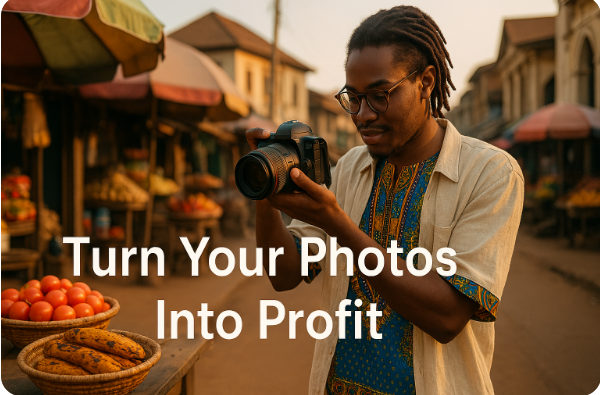15 Best Websites to Sell Photos Online in 2025 (Proven Strategies + Real Earnings)

Looking to sell your photos online in 2025? Discover the 15 best websites for photographers and creators to earn real income from their images — even as a beginner!
Introduction
Did you know that the global stock photography market is projected to surpass $6 billion by 2025? Whether you’re a DSLR enthusiast, smartphone snapper, or seasoned creator, there’s never been a better time to monetize your photography skills.
Selling photos online used to be reserved for professionals with industry connections. Today, creators of all levels can upload, license, and earn from their photos across dozens of platforms.
In this comprehensive guide, we’ll uncover the 15 best websites to sell photos online in 2025, explain how they work, explore real case studies, and show you how to maximize your income. Whether you shoot landscapes, food, fashion, or flat lays, this is your step-by-step roadmap.
Table of Contents
- What Does Selling Photos Online Mean?
- Why Selling Photos Online Still Works in 2025
- Case Study: How a Travel Photographer Earned $4,500 in 8 Months
- Step-by-Step Guide to Selling Photos Online
- Common Mistakes to Avoid
- Top 15 Platforms to Sell Photos in 2025
- Additional Case Studies & Creator Tips
- Final Thoughts
- Frequently Asked Questions
What Does Selling Photos Online Mean?
Selling photos online means uploading and licensing your digital images on platforms where businesses, bloggers, designers, and advertisers can purchase usage rights. You typically earn money per download, per license sold, or through royalties.
📸 Brief History
- Early 2000s: Stock agencies like Getty Images dominated the market.
- 2010s: Microstock sites (e.g., Shutterstock, iStock) democratized access.
- 2020s: Creator platforms, direct-to-buyer models, and AI curation changed the game.
🔥 Trends in 2024–2025
- Mobile photography accepted on pro platforms.
- Demand for authentic, diverse, and real-life imagery is soaring.
- Niche stock libraries are on the rise (e.g., black-owned businesses, eco travel, flat lays).
Why Selling Photos Online Still Works in 2025
Selling photos remains a viable income stream in 2025 for three major reasons:
- Content Explosion: Over 7 million blog posts and 500,000+ marketing campaigns are created daily — all needing images.
- Remote Monetization: Creators in Nigeria, India, and Eastern Europe are earning in dollars by selling online.
- AI Can’t Fully Replace Real Photos (yet): Real emotion, diversity, and natural lighting are still highly valued.
Stat: Shutterstock alone paid out over $1 billion to contributors as of 2024.
Case Study: How a Travel Photographer Earned $4,500 in 8 Months
🎒 Meet: Elijah N., a Nigerian travel photographer
- Platform used: Adobe Stock, Alamy, and EyeEm
- Photos uploaded: 600+ nature, food, and local lifestyle shots
- Time spent: ~10 hrs/week
- Earnings: $4,500 in 8 months
“I focused on authentic African scenes — food markets, street culture, landscapes. Global brands are hungry for real stories,” Elijah shares.
🔑 Key Takeaway:
Niche + consistency beats generic mass uploads.
Step-by-Step Guide to Selling Photos Online
Breaking into the online photography market doesn’t require expensive gear or years of experience. What it does require is strategy, consistency, and an understanding of how buyers search and select images.
Below is a clear, beginner-friendly framework that seasoned creators still use in 2025 to turn everyday photos into ongoing revenue.
✅ Step 1: Choose Your Niche — Don’t Be a Generalist
One of the biggest mistakes new contributors make is trying to shoot everything — sunsets, food, portraits, pets, cityscapes — without mastering or focusing on any.
Successful photo sellers choose a niche that aligns with:
- Their personal interest or lifestyle
- Market demand
- Available local content (your environment can be your edge)
🔑 Why Niching Down Matters:
- Platform algorithms favor contributors with consistent styles or themes
- You become recognizable for a specific type of photo
- Your portfolio tells a clearer story to buyers and gets more saves, follows, and downloads
🔍 Popular & Evergreen Niches in 2025:
| Niche | High Demand Uses | Suggested Focus Areas |
|---|---|---|
| Food & Drink | Recipes, blogs, ads, packaging | Top-down meals, drinks in hand, local dishes |
| Fitness & Health | Wellness brands, online coaches | Yoga, home workouts, supplements, activewear |
| Diversity & Inclusion | Corporate stock, lifestyle blogs | Diverse ethnicities, ages, LGBTQ+ representation |
| Tech & Remote Work | Business, productivity tools | Flat lays, virtual meetings, laptop setups |
| Fashion & Lifestyle | Magazines, ecommerce, IG ads | Street style, outfit inspiration, accessories |
| Nature & Travel | Print sales, editorial, tourism boards | Landscapes, local traditions, architecture |
| Urban Life & Culture | News, blogs, social commentary | Daily scenes, public transport, street stories |
| Family & Relationships | Parenting blogs, insurance ads | Moments with kids, seniors, couples, emotions |
🎯 Pro Tips:
- Start by documenting your real life: Are you a student? Capture your campus life. A new parent? Capture family routines.
- Use tools like Canva, Shutterstock’s Contributor Portal, or Alamy Trends to see what’s currently in demand.
- Research top-selling photos in your niche. Look for composition, colors, tags, and what emotions they evoke.
💡 Example:
If you live in Lagos and frequently visit outdoor markets, you might focus on:
- Local food scenes
- Street vendors
- Cultural fashion
- Urban movement (motorcycles, street traffic)
This type of content is in high demand by international brands looking for authentic, diverse imagery — and you’ll face far less competition than someone uploading another picture of Times Square or a latte.
✅ Step 2: Select the Right Platforms — Where You Sell Determines What You Earn
Once you’ve chosen your photography niche, the next step is to choose where to upload your photos. Not all platforms are created equal — some prioritize volume and accessibility, while others focus on exclusivity and premium licensing.
Your income, visibility, and growth as a contributor depend heavily on selecting the right mix of platforms that match your content, goals, and skill level.
🎯 Understand the Two Main Types of Photo-Selling Platforms
| Platform Type | Characteristics | Ideal For |
|---|---|---|
| Microstock | High traffic, lower prices, fast approvals | Beginners, volume uploaders |
| Premium/Curated | Fewer sales, higher payouts, stricter entry | Experienced creators, unique styles |
🔁 Combine Both:
- Upload to microstock sites like Shutterstock or Adobe Stock to get consistent downloads and passive income.
- Apply to premium libraries like Stocksy or Getty Images to license high-quality content at higher prices.
🧭 Match Platform Focus to Your Photography Style
Each platform has a different target audience and content preference. Uploading fitness photos to a site that specializes in editorial news photography won’t yield strong results.
Here’s a breakdown of where different styles thrive in 2025:
| Your Style | Best Platform(s) | Why They Work |
|---|---|---|
| Lifestyle, Diversity, People | EyeEm, Adobe Stock, Canva | High demand for authentic real-world shots |
| Artistic, Editorial, Travel | Stocksy, Alamy, 500px Prime | High-paying licenses, curated buyers |
| Food, Flat Lays, Branding | Shutterstock, Creative Market, Canva | Used for blogs, menus, digital design |
| Urban & Documentary | Getty Images, Alamy, PicFair | Popular in journalism and commercial use |
| Smartphone Photography | Foap, EyeEm, Dreamstime Mobile | Easy mobile uploads, crowd-sourced curation |
| Custom Prints or Wall Art | Etsy, SmugMug, Zenfolio | Direct-to-buyer or print-on-demand |
💸 Compare Commission & Payout Models
| Platform | Payout Range | Notes |
|---|---|---|
| Shutterstock | 15%–40% | Based on contributor level, millions of users |
| Adobe Stock | Flat 33% | Better earnings than most microstock sites |
| Alamy | Up to 50% | High licensing fees, editorial and commercial |
| EyeEm | 50% (via Getty) | Focus on AI tagging, authentic content |
| Stocksy | 50%–75% | Application required, artist-owned coop |
| Foap | 50% per photo sale | Includes brand missions and contests |
| Canva | Variable | High demand, especially for social/web photos |
| Etsy | You set the price | Best for physical prints and art licensing |
🔍 Pro Tips Before You Upload
- Read contributor agreements carefully. Some platforms require exclusivity — meaning you cannot upload the same photo elsewhere.
- Track your analytics. Which photos perform best and where? Use that data to refine what and where you upload.
- Use tools like Wirestock or BlackBox if you want to distribute your photos across multiple platforms easily (but be mindful of fees or reduced control).
💡 Real-World Strategy Example:
Joshua, a part-time photographer from Kenya, uploads portraits and local market scenes to EyeEm and Alamy for premium licensing — but also uses Shutterstock and Foap for mobile lifestyle content. His earnings are diversified and steadily growing across 4 platforms.
Bottom Line:
Choose platforms that reward your style, match your skill level, and support your long-term goals. It’s better to be intentional with 3 platforms than to blindly upload to 10.
✅ Step 3: Optimize Photos for Search — Make Your Work Discoverable
No matter how stunning your photo is, it won’t sell unless buyers can find it. That’s where photo SEO (Search Engine Optimization) comes in.
On stock platforms, just like on Google, titles, tags, and descriptions determine whether your image appears in front of the right buyer. Optimization isn’t optional — it’s the engine of discoverability and sales.
Let’s break down exactly how to optimize your uploads in 2025.
🏷️ 1. Use Descriptive, Keyword-Rich Titles
Your photo title is the first thing algorithms and buyers read. It should be natural, detailed, and reflect what’s visually present in the image.
✅ Good Title Example:
“Young African woman smiling while using a smartphone in a cozy Lagos café”
❌ Poor Title Example:
“Woman with phone” — too vague, lacks location or mood.
🎯 Title Tips:
- Describe the main subject, action, and context (who, what, where)
- Include location or setting if relevant
- Avoid overly artistic or generic phrases (e.g., “Hopeful Dreams”)
🧠 2. Add Smart, Relevant Tags (Keywords)
Tags are the bridge between buyer searches and your photo. Platforms use them to understand the content and match it to search queries.
Example for above photo:
- african woman, lagos, smartphone, cafe, smiling, digital lifestyle, casual, young adult, urban life, tech usage, sitting indoors
🔍 Best Practices:
- Use 15–50 tags (depending on platform limits)
- Think like a buyer: What might someone search to find this image?
- Include synonyms and variants (e.g., “phone” and “mobile device”)
- Use contextual keywords: emotions, activity, environment
🗂️ 3. Choose the Right Category or Subcategory
Most platforms allow you to assign photos to predefined categories (e.g., Business, People, Nature, Education).
📌 Why it matters:
- Helps search filters display your photo in the correct sections
- Improves targeting accuracy for platform-curated collections
Pro Tip:
If the platform allows multiple categories, select both subject and application context (e.g., “People” + “Technology”)
📄 4. Write Clear, Informative Descriptions
Descriptions support your tags and help buyers understand how they can use your image.
Example:
“A candid shot of a young Nigerian woman smiling while using her smartphone in a modern café in Lagos. Captures digital lifestyle, technology usage, and urban youth culture. Suitable for articles, blog posts, and marketing campaigns focused on tech adoption, social media, or African city life.”
Description Checklist:
- 1–2 full sentences
- Cover what’s happening, who’s involved, and where it is
- Suggest potential use cases (e.g., blog, ad, presentation)
- Include keywords naturally (don’t stuff)
🔄 5. Leverage Platform-Specific Tools
Some platforms provide built-in SEO assistance:
| Platform | SEO Features |
|---|---|
| EyeEm | AI auto-tagging (edit tags as needed) |
| Adobe Stock | Smart keyword suggestions via Lightroom |
| Shutterstock | Auto-suggested tags and trending keyword tool |
| Wirestock | Semi-automated keywording + AI help |
🚫 Watch Out For:
- Irrelevant or misleading tags (can lower search ranking)
- Repeating the same word in tags and title excessively
📈 Bonus: Keep SEO Consistent Across Your Portfolio
- Use a tag template for similar shoots (e.g., travel, tech, fitness)
- Track your best-performing tags and titles in a spreadsheet
- Study popular images on each platform for tag inspiration
⚡ Quick Optimization Example:
Image: A man jogging at sunrise on a quiet road in Nairobi
Title:
“African man running at sunrise on an empty road in Nairobi”
Tags:
african man, jogging, sunrise, road, fitness, health, morning, cardio, running outdoors, kenya, motivation, active lifestyle
Description:
“An early morning photo of an athletic African man jogging on a quiet road in Nairobi. Ideal for fitness, wellness, or lifestyle-related content. Highlights movement, determination, and healthy routines.”
Bottom Line:
Optimizing your photos for search is the single most important skill for turning beautiful shots into bankable assets. Treat every upload as an SEO asset — because that’s exactly what it is.
Step 4: Upload Consistently
- Platforms reward active contributors.
- Aim for weekly uploads and quality over quantity.
Step 5: Promote Your Portfolio
- Link your collections on social media, photography forums, or your website.
- Collaborate with bloggers or content creators.
Common Mistakes to Avoid
- Using Generic Titles
❌ Bad: “People”
✅ Better: “Three friends laughing at beach sunset” - Ignoring Licensing Terms
Learn the difference between royalty-free, editorial, and extended licenses. - Uploading Unedited Photos
Use Lightroom or Snapseed to polish without over-processing. - Skipping Model Releases
Always use release forms for recognizable faces. - Spamming Platforms
Avoid uploading 1000 random photos; curate your best 200.
Top 15 Platforms to Sell Photos in 2025
Here’s a breakdown of the top websites with pros, cons, and links:
| Platform | Key Features | Commission | Ideal For |
| Shutterstock | Massive reach, daily downloads | 15%–40% | High-volume contributors |
| Adobe Stock | Integrated with Creative Cloud | 20%–35% | Professional creatives |
| Alamy | High payout, editorial allowed | 40%–50% | Premium/lifestyle photos |
| Getty/iStock | Premium brand, strict quality control | 15%–45% | Top-tier photographers |
| 500px | Licensing + community features | Up to 60% | Artistic & nature shots |
| Canva | Huge graphic design user base | Varied | Lifestyle, flat lays, tech |
| Dreamstime | Long-standing, reliable | 25%–50% | General stock photography |
| Foap | Smartphone app, missions/challenges | 50% | Beginners, mobile shooters |
| EyeEm | AI-tagged photos, connected to Getty | 50% | Authentic lifestyle photos |
| DepositPhotos | Global buyers, flexible plans | 34% | Freelancers, general stock |
| Stocksy | Artist-owned, curated library | 50%–75% | Exclusive, artistic portfolios |
| SmugMug | Direct sales, portfolio hosting | Varies | Wedding/event photographers |
| PicFair | You set your price | You set it | Independent photographers |
| Etsy | Print sales, digital downloads | You set it | Print-on-demand & wall art |
| Zenfolio | Storefront, prints, subscriptions | Varies | Entrepreneurs, client work |
Additional Case Studies & Creator Tips
🎯 Case Study 2: Sarah from London
- Made £8,000 in 2024 selling dog photography via Etsy + PicFair.
- Tactic: Niche into pet portraits with customizable templates.
🎯 Case Study 3: Ben from South Africa
- Combines Adobe Stock & Canva — food & culture images.
- Focus: Weekly uploads + SEO tags.
“Consistency matters more than equipment,” Ben says. “Even smartphone shots sell if they’re well-lit and real.”
Final Thoughts
In 2025, selling photos online isn’t just for full-time professionals — it’s a viable side hustle or career for anyone with a camera and an eye for moments.
By choosing the right platforms, understanding how to tag and license your content, and staying consistent, you can build an income stream that scales over time.
Whether you’re shooting from a smartphone in Lagos or a DSLR in Berlin, the tools and platforms are ready — your next photo could pay your next bill.
🙋 Frequently Asked Questions
Q: Can I sell photos taken with a smartphone?
A: Absolutely. Many platforms like Foap, EyeEm, and even Shutterstock accept high-quality smartphone images. Focus on lighting, clarity, and originality.
Q: Do I need a model release form?
A: Yes, if your photo includes recognizable faces and is used for commercial purposes. Editorial photos (e.g., news or public events) may not require one.
Q: How much money can I realistically make?
A: It varies. Beginners may earn $50–$300/month. With volume and quality, earnings can exceed $1,000+/month over time.
Q: Can I sell the same photo on multiple websites?
A: Yes, unless a platform requires exclusivity (like Stocksy). Most microstock sites allow non-exclusive contributions.
Q: What are the best tags to use?
A: Use descriptive and relevant keywords: subject, location, emotion, action, format. Example: “African market”, “sunset”, “family walking”, “aerial view”.
Q: Is selling photos passive income?
A: Yes, once uploaded, you earn royalties per download. However, ongoing uploads increase your visibility and sales.
Q: Do I need professional equipment?
A: Not at all. Composition, subject matter, and emotion often matter more than gear. Even phones like iPhone 13+ or Samsung Galaxy S21 produce usable content.

I'm Abraham Itunnu An Entrepreneur, Forex Trader, Writer, Web Designer. Please this website is not a Get Rich Quick Scheme. You need to put things to work so acheive good results.
Click Here To Learn The Exact Steps




Recent Posts
- How to Scale Your AI Side Hustle to ₦200,000+ Per Month in Nigeria (2026 Guide)
- Step-by-Step Guide to Making Your First ₦50,000With AI (2026 Edition)
- How to Use ChatGPT to Make Money in Nigeria (2026 Guide)
- 5 Ways Nigerians Can Earn in Dollars Using AI Tools (2026 Guide)
- How Students & Side Hustlers Can Use These AI Tools to Make Money in 2026





















